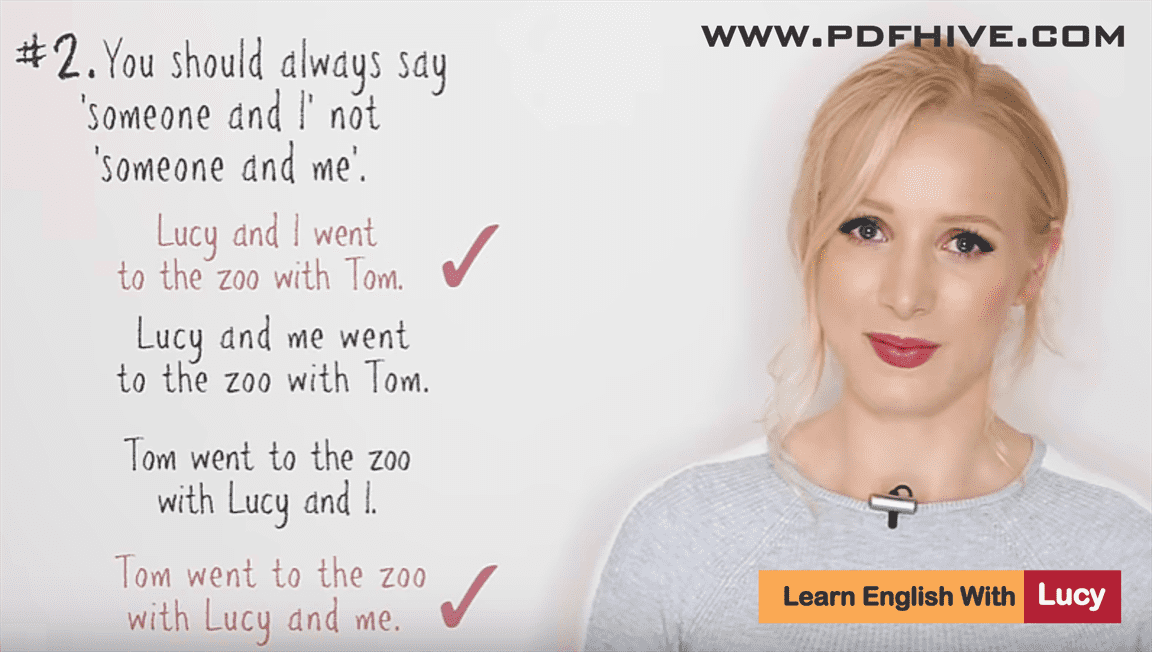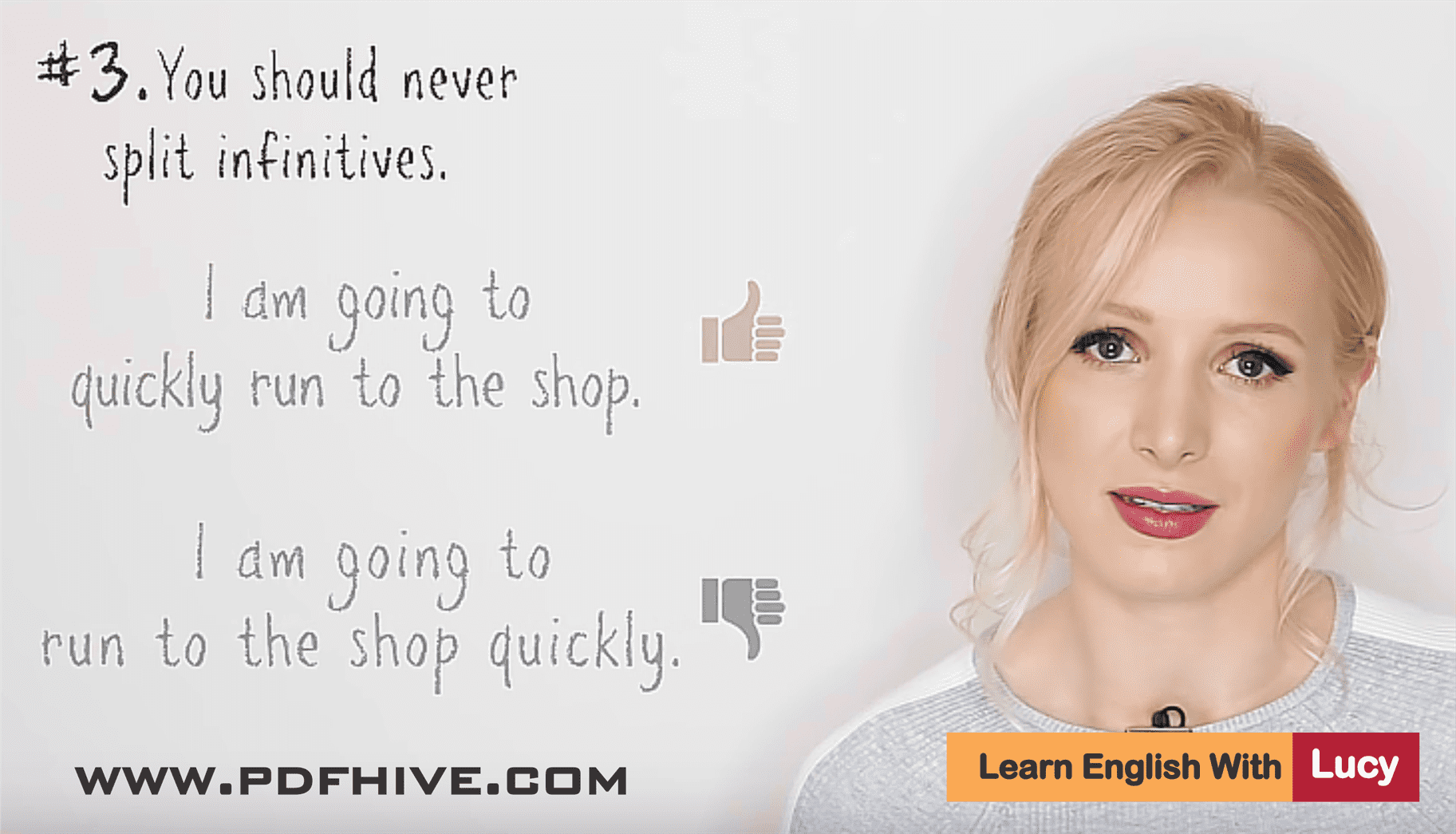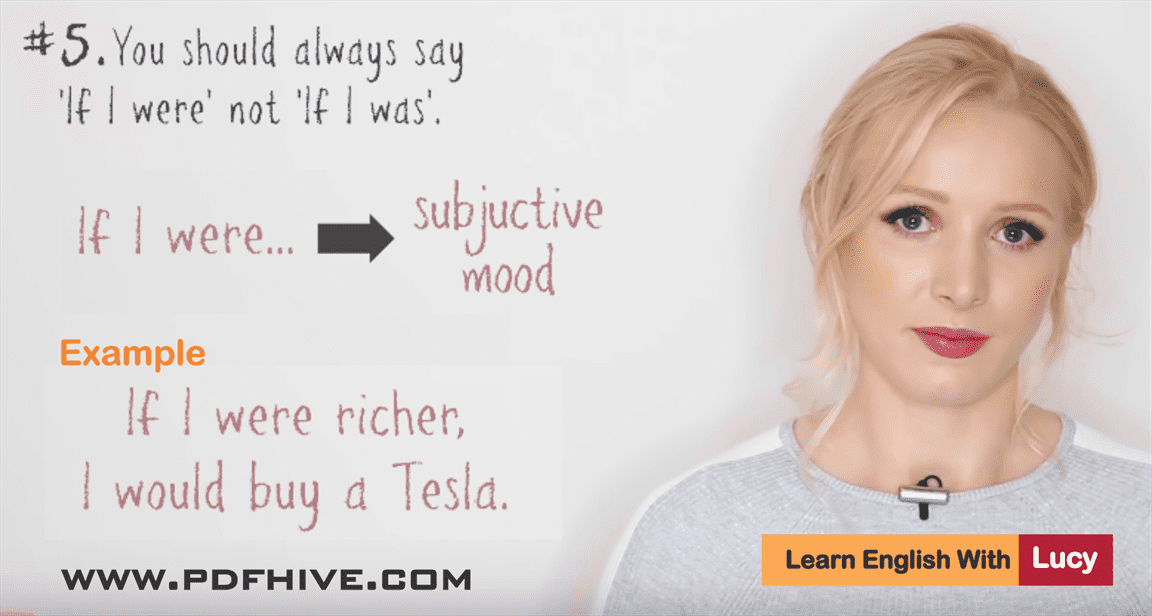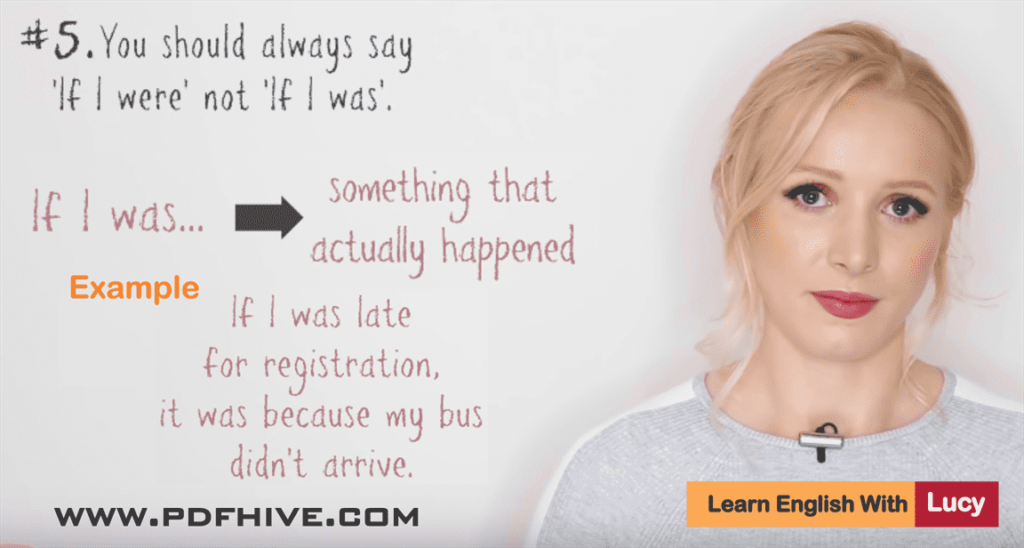Five strict English grammar rules | English with Lucy
English Grammar Rules | English with Lucy: Hello everyone and welcome back to English with Lucy. Today I am going to teach you about five strict English grammar rules that natives don’t always follow. Yes, that’s right. Your teacher may have been lying to you.

Right, let’s get started with the lesson. All right, let’s start with the first rule of English. There are no rules. That’s just a joke. There are many rules, but we don’t follow all of them and that is what this article is about. I just thought that was a lovely example of how confusing language is.
FIVE English Grammar rules | English with Lucy
Let’s started with five strict English grammar rules that natives don’t always follow. And I’m going to teach you these for your further concepts about casual English Grammar rules.
- You should never end a sentence with a preposition | English with Lucy
- Always say someone and I, not someone and me | English with Lucy
- Never split an infinitive | English with Lucy
- Always use “there are” instead of “there is” before a plural | English with Lucy
- If I were rather than if I was | English with Lucy
Here is the best video that is explaining these five Strict English Grammar rules from English with Lucy YouTube channel!
https://youtu.be/XyvBFI49FOk
1. You should never end a sentence with a preposition | English with Lucy
Now, the first rule that we like to break and the rule that doesn’t always apply, many teachers will tell you that you should never ever end a sentence with a preposition. Well, I’m about to prove your teacher’s wrong. There are quite a few situations in which you can end a sentence with a preposition. Now, if you can remove the preposition from the end of a sentence without it changing the meaning of the sentence, then you should do that.

But what about situations in which the meaning has changed? Oh, let’s talk about phrasal verbs. These other verbs made of a verb and at least one preposition. Keep up, run down, get up, and put on, often sentences that use phrasal verbs, end with a preposition.
For example, I think you should get up. Or I hope you can come over. Both of these sentences end with a preposition and it can’t be avoided. If we remove the preposition, the meaning will change and we can’t really rearrange it to avoid the preposition being put at the end.
Sometimes it’s even okay to end a sentence with a preposition even if you aren’t using a phrasal verb, you might be able to rewrite these sentences to avoid them ending with a preposition, but it’s not always necessary. You might be over complicating things.
For example: Does anyone know where he came from? I could rewrite the sentence to say, does anyone know from where he came? But it would sound so unbelievably old fashioned. Does anyone know where he came from? Is perfectly fine.

2. Always say someone and I, not someone and me | English with Lucy
Right, rule number two in English Grammar rules, the rule I want to debunk, you should always say someone and I, not someone and me. This one is close to my heart because I had it drummed into me when I was at school both by my teachers and my mother, and my teachers and my mother were misinformed at school.
Let’s take a look at four sentences all regarding the zoo.
- Lucy and I went to the zoo with Tom.
- Lucy and me went to the zoo with Tom.
- Tom went to the zoo with Lucy and I.
- Tom went to the zoo with Lucy and me.

Two of these sentences are incorrect and two of them are correct. The question of whether to use I or me, it comes down to whether you’re using the word as a subject or an object in the sentence. Both words are pronouns, but I as a subject pronoun and me is an object pronoun.
Native speakers, you can be forgiven for getting confused with this. I never learned this at school, so after the first two, Lucy and I went to the zoo with Tom, it would be correct because I is the subject of the sentence. You can work this out by removing the extra bit, the Lucy and bit does it work on its own? I went to the zoo with Tom, or me went to the zoo with Tom. Well, me went, sounds very, very wrong. So it’s, I went.
However, in the second two sentences it is the opposite. Remove Lucy and again, in the second two sentences, Tom went to the zoo with I, sounds weird. So it’s Tom went to the zoo with me.
Tom went to the zoo with Lucy and me. In this case me is the object of the sentence. So many native speakers will always be taught to say someone and I, when actually in many cases, someone and me is the correct version.
3. Never split an infinitive | English with Lucy
Number three, a big English Grammar rule that came up recently after I used one of these in a title of my videos, it is that you should never split an infinitive. Many teachers will tell you this because they are simplifying things a little bit, but in reality we do split infinitives. So infinitives are the two word forms of verbs like to run, to laugh, to play.

When you split an infinitive, you put something normally an adverb between those two words, for example, to quickly run, to carefully read, to playfully dance. So often it’s a case of it just sounding better when we split an infinitive, it sounds more natural. For example, I’m going to quickly run to the shop. This sounds better than I’m going to run to the shop quickly.
But in some more complex cases, moving the adverb can actually change the meaning of the sentence. Take a look at this sentence. I’m going to really kiss him when I see him. If I say I’m going to really kiss someone, it means that it’s going to be quite a kiss, a big kiss, a very strong one. If I say, I am really going to kiss him when I see him, rather than talking about the strength of the kiss, I’m almost conveying a sense of determination. It’s only a slight difference, but it does change the meaning.
Now, some sentences actually require a split infinitive, which makes it all the more bananas that teachers tell you to never split an infinitive. Let’s go straight in with an example. He expects the staff numbers to more than triple over the next five years. You can’t move more than in this sentence. You can’t put it in another place whilst retaining the meaning. This sentence requires a split infinitive.
4. Always use “there are” instead of “there is” before a plural | English with Lucy
Number four is, we should always use there are instead of there is before a plural. So many teachers will tell you always use there is then a singular and there are then a plural, this doesn’t always apply. People get very upset about it.
Write in the comment section, if I use there is before what they consider to be a plural, I’m going to explain that use. But I would admit many native speakers, myself included, do make mistakes and get confused with “there is” and “there are”, because we speak so quickly that we don’t give ourselves time to plan whether there is needed or there are is needed.

So just to cover the basics we use there is, and there are, when we first refer to the presence or existence of someone or something. There is and also there’s are both singular forms. There’s is the reduction of there is. There is, there’s. There’s is most commonly used in informal speaking.
So instead of saying it is a fly on my head, we would say there’s or there is a fly on my head. There are, is the plural form of there is and there’s. An example, there are two spots on my face. Now in speaking and in some informal writing, we sometimes use there’s when it refers to more than one thing.
Bear in mind that this use can be considered incorrect in examinations. It’s not uncommon to hear native speakers make this mistake. I might say there’s many cakes instead of, there are many cakes because I’m just so used to saying there’s all the time. There’s one apple, there’s two apples. It feels almost natural to me.
Now this is considered to be incorrect. However, there are actually some situations in which it is considered to be it correct to use there’s then a plural. Let’s have a look at collecting phrases. One in particular is a number of, a number of, would I say there is a number of cakes for sale. There’s a number of cakes for sale, or there are a number of cakes for sale.
Well it’s actually really difficult to work out. In a construction like this the verb is being pulled to there, number, and cakes all at once. You can work out whether you should use there is or there are in this situation by focusing on emphasis.
Use is if you want to emphasise the group as a whole, there is a number of, the group cakes or use are if you want to emphasise the individual members of that group, each individual cake, there are a number of individual cakes.
This works with a number of, collecting phrases like a variety of, there is a variety of drinks at the bar. Or there are a variety of drinks at the bar. Both work depending on what you want to emphasise.
Now we do use there are when talking about a lot of, and this is a mistake that a lot of native speakers make, myself included. Again, we shouldn’t say there’s a lot of people in the room. We should say there are a lot of people in the room. But you will hear this mistake made. Now with the phrase, there is two dogs, ever be correct. Well, sort of if two dogs were included as part of a list, sometimes there are just sounds wrong. I wouldn’t say there are a cat, two dogs and a cow on the farm. I would say there is a cat, two dogs and a cow on the farm.
So that is a clear example of there is used before a singular but a singular formed as part of a list.
Some grammar lovers will still insist that this is incorrect but I’m not with them on this one. It just sounds wrong. If you are ever in doubt, you can actually rewrite the sentence to avoid using there is and there are.
5. If I were rather than if I was | English with Lucy
The last rule number five, in English Grammar rules series, you should always say if I were rather than if I was. Now, you will hear a lot of people making a mistake with if I were and if I was, they will say if I was when they are meant to say if I were, however again, I was brought up to always say if I were, when actually in some situations if I was is correct and if I were is incorrect. Shocker!
For example, if I were richer, I would buy a Tesla. True story, I would. I really would like an electric car, but I need one that will go over farmland. Anyway, if I were richer, I would buy a Tesla. I am imagining a situation in which I am richer, a hypothetical situation and I’m imagining what I would do in that situation, what that would mean for that version of myself.

Now we use the phrase, if I was, if we are referring to something that did actually happen, so we have, if I were hypothetical, if I was actually happened reality, so we often use it for reminiscing. An example, if I was late for registration when I was at school, it was because my bus didn’t arrive. This isn’t the most commonly used phrase on earth, but it’s important to know that sometimes if I was is correct. Right, that’s it for today’s lesson.

Conclusion
I hope you enjoyed it. I hope you learned something. I really enjoyed doing the research for this English Grammar rules article. It was a quite surprising to see how much misinformation was spread around my primary, middle and upper schools.
Don’t forget to connect with me on all of my social media. I’ve got my Facebook, my Instagram, my Twitter, and my personal channel, Lucy Bella Earl. I will see you soon for another lesson.







Excellent style of learning
[…] Five strict English grammar rules that natives don’t always follow | English With Lucy […]